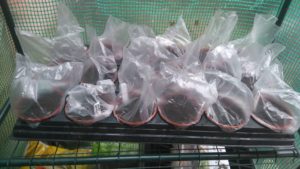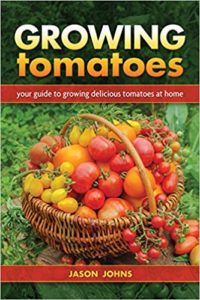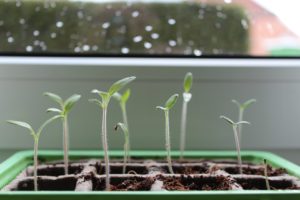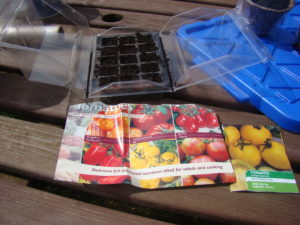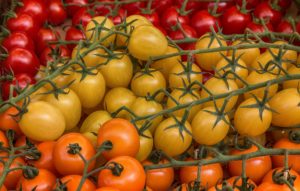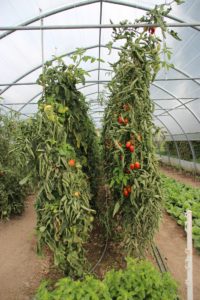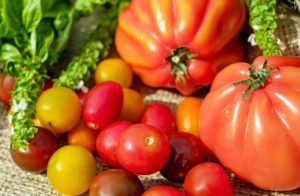Most people start their tomato plants off from seed, which isn’t particularly difficult to do. The advantage of growing from seed is that you have access to a much wider choice of varieties. When you buy pre-grown plants you can usually only find a few of the most commonly grown varieties. Pre-grown plants are useful though, so please don’t dismiss them. If you find you have extra space, seeds fail to germinate or young plants die (usually a cat related incident in my household), then pre-grown plants are the perfect solution so you still get a crop of tomatoes.
When and Where to Start
Tomato seeds are always started indoors, unless you live in a very hot climate. Whether they are under lights, in a greenhouse or on a window ledge, starting them indoors gives your plants a head start so they can mature during the growing seasons. Depending on the variety it can take anything from 70 to 80 days and up to 100 for a plant to fruit from sowing the seed. In more northerly areas, the outdoors growing season may not be long enough to allow the plant to mature and the fruit to ripen.
Young plants are kept indoors until the risk of frost has passed, if you are planting them outdoors. During this time, you keep transferring them to larger and larger pots until they are ready to plant out.
Tomato seeds need a temperature of between 60-80F/15-27C to germinate, which can be as late as midsummer in temperate climates, which is far too late for the tomatoes to mature fully. In most areas, tomato seeds are sown between the end of January and April, depending:
- How long the growing season is where you live
- The time to mature of the variety you are growing
- The space you have to keep the plants while waiting for the risk of frost to pass
If you do not have a lot of space indoors for the plants then look at growing a short season variety and starting in March or April so they have to spend less time indoors.
Remember, though, when you are transferring your tomato plants from indoors to outdoors to harden them off fully otherwise they suffer from transplant shock. This can stunt the growth by anything up to a month, which could mean the fruit do not have the time to ripen or, in the worst cases, kill your plant completely.
As a rough rule of thumb, start your tomato seeds between six and eight weeks before the average date of the last frost. Remember, tomatoes originated in the tropics, so love warmth and cannot survive in the cold.
Look up your last frost date online on a site such as this https://www.almanac.com/gardening/frostdates(USA) or this one https://www.plantmaps.com/interactive-united-kingdom-last-frost-date-map.php for the UK. Count backwards six to eight weeks from the date it provides you and you know when to start your tomato seeds!
Start your tomatoes off in a good quality seed compost. Buy the best you can afford as the cheap composts tend to be more lumpy and do not drain as well, which can cause the seeds/seedlings to rot. Either grow in individual pots (I start mine in 3″ plastic pots) or in cell packs. Sow a single seed per cell or pot. Some people sow two seeds per pot and remove the weaker of the two, but I sow one per pot as I can’t cope with having to destroy a perfectly healthy plant and they are often too tightly entwined to separate.
You can buy peat or cardboard pots, but I don’t recommend these as in my experience they tend to dry out far too quickly or become too wet and grow moldy.
I like to mix the compost with perlite or vermiculite because it helps the soil retain water better plus helps prevent the compost from becoming waterlogged.
The three main steps in sowing tomato seeds are:
- Fill the pots with compost until there is 1/2 inch of space between the top of the compost and the top of the pot. Place one (or two if you prefer) seed(s) in the middle of the pot.
- Cover with a quarter inch of soil and lightly press down on the soil – the seed needs to be in contact with the soil to germinate successfully
- Carefully sprinkle with water – use a small watering can with a fine rose or use a spray bottle set on mist. Spray whenever the top of the compost looks dry; but don’t keep the soil soggy as the seed can rot
This video shows me planting some tomato seeds in a mini propagator:
This short video is watering in the seeds:
Once this is done, place the pots in a sunny window or greenhouse, where they get at least four hours of sun per day; though more is better. The seeds need warmth to germinate, so many people will use grow lamps or heated mats/propagators to ensure a high germination rate. I’ve covered my pots with plastic wrap or plastic bags which acts like a mini-greenhouse, though you do need to keep a close eye on your pot that it doesn’t dry out or get too soggy. As soon as the seed germinates, remove the cover otherwise the seedlings could die due to damping off disease, which is a problem with tomato seeds. Using a small fan to circulate the air can reduce the risk of this disease. Be careful about opening a window as the cold air could hinder germination and growth.
When your seedlings have two true leaves, then it is time to transplant them to a larger pot. We’ll talk about that more in the next edition of this series as well as discuss the hardening off process and more.
Discover everything you need to know about growing tomatoes in my new book, “Growing Tomatoes” available in paperback and ebook in the UK here and the rest of the world, including the USA here.

